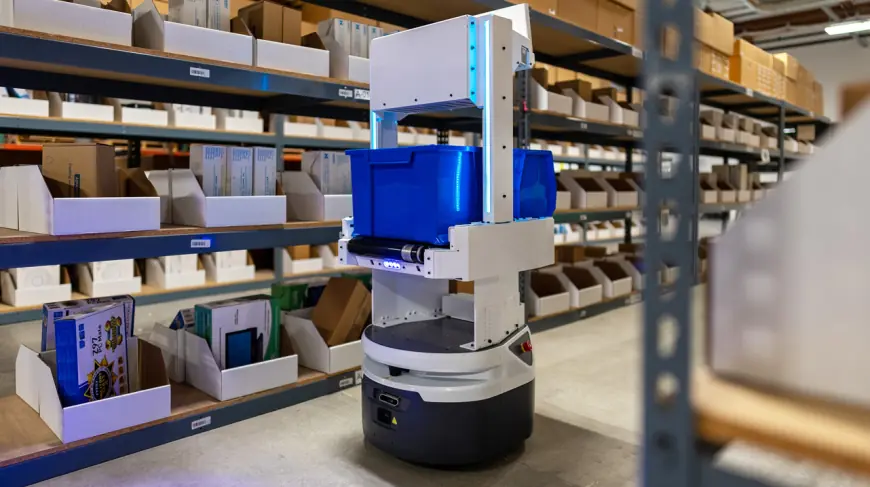The Role of Autonomous Mobile Robots (AMRs) in Warehouse Automation
This article explores the role of AMRs in warehouse automation, detailing their functions, advantages, implementation strategies, and the future of AMR-powered warehouses.

Warehouse automation has been a cornerstone of modern supply chain innovation. With businesses continually striving to improve efficiency, reduce costs, and increase throughput, technologies like Autonomous Mobile Robots (AMRs) have taken center stage. AMRs are revolutionizing warehouse management by transforming traditional labor-intensive operations into streamlined, more efficient systems.
What are Autonomous Mobile Robots (AMRs)?
Autonomous Mobile Robots (AMRs) are robots that can navigate and perform tasks without human intervention. They use a combination of sensors, cameras, lasers, and onboard computers to interpret their surroundings, make decisions, and adapt to changes in the environment. Unlike traditional Automated Guided Vehicles (AGVs), which follow fixed paths, AMRs can navigate dynamically, adapting to obstacles and changes in their environment. This makes them highly flexible and capable of performing a wide range of tasks in various warehouse settings.
AMRs are typically used to transport goods, such as pallets or totes, from one location to another within a warehouse. They can also be equipped with tools for specific tasks like sorting, picking, and packing. Thanks to their sophisticated navigation and mapping capabilities, AMRs can work seamlessly alongside human employees and other automated systems, making them an ideal solution for enhancing warehouse efficiency.
Key Benefits of AMRs in Warehouse Automation
-
Improved Efficiency
One of the most significant benefits of implementing AMRs in warehouses is the improvement in operational efficiency. AMRs can run continuously, working around the clock without the need for breaks, reducing downtime. They can also optimize routes and choose the fastest paths to their destination, ensuring that goods are moved as quickly as possible. This leads to a reduction in lead times and an increase in throughput.
-
Cost Savings
While there are upfront costs associated with purchasing and integrating AMRs into a warehouse system, over time they can lead to substantial cost savings. AMRs reduce the reliance on manual labor, lowering wages and associated costs. They also help minimize errors, damage, and product loss, which can result from human mistakes. By streamlining operations, AMRs contribute to reducing operational costs and maximizing profitability.
-
Scalability
AMRs are highly scalable, which makes them a versatile solution for warehouses of all sizes. Whether a warehouse is handling a few orders a day or thousands, AMRs can easily be added to the system as demand grows. Since AMRs can adapt to changes in layout and storage configurations, businesses can expand their automation without needing to completely overhaul existing systems.
-
Increased Safety
AMRs improve warehouse safety by reducing the need for employees to engage in dangerous or physically demanding tasks. Moving heavy pallets, lifting boxes, and operating forklifts can expose workers to significant risks, including musculoskeletal injuries and accidents. By automating these tasks, AMRs reduce the risk of injury and create a safer working environment for employees.
-
Enhanced Flexibility
Unlike fixed automation systems, which require extensive reconfiguration when the layout of the warehouse changes, AMRs are highly adaptable. They can navigate around obstacles, find new paths, and adjust to changes in the warehouse environment. This flexibility allows businesses to modify their operations or warehouse layout without disrupting the entire automated system.
How AMRs Work in Warehouse Automation
AMRs are equipped with a variety of sensors and technologies that allow them to perform their tasks effectively. Some of the primary components include:
-
Navigation Sensors
These sensors help AMRs map and navigate their environment. Common sensors used in AMRs include LIDAR (Light Detection and Ranging), cameras, and ultrasonic sensors. LIDAR is particularly important as it allows the robot to create a detailed map of the warehouse and detect obstacles in real-time. This allows the AMRs to plan optimal routes and avoid collisions.
-
Artificial Intelligence (AI)
AI plays a crucial role in AMR operation. Through machine learning algorithms, AMRs can improve their navigation capabilities and decision-making processes over time. For example, AMRs can learn the best routes for transporting goods based on past experiences and environmental conditions.
-
Battery and Charging Systems
AMRs rely on rechargeable batteries to operate, and their battery management systems ensure that they have enough power to complete tasks. Some AMRs are equipped with automatic charging stations, enabling them to recharge themselves when their batteries run low, ensuring continuous operation without requiring human intervention.
-
Communication Networks
AMRs rely on wireless communication systems to stay connected to the warehouse’s central control system. This allows them to receive task assignments, share updates, and report status changes. A robust communication system ensures that the AMRs work together efficiently and can seamlessly coordinate with human workers and other automated systems.
-
Fleet Management Software
When multiple AMRs are deployed in a warehouse, fleet management software is essential to coordinate their movements. This software helps to optimize the assignment of tasks, track the location of each robot, and ensure that they are working in sync with each other. It can also help in troubleshooting and managing maintenance schedules for the robots.
Types of Tasks Performed by AMRs
AMRs can perform a variety of tasks in the warehouse, depending on their capabilities and the specific needs of the business. Some of the most common tasks include:
-
Material Transport
The primary function of most AMRs in warehouses is material transport. AMRs can move goods from one area to another, whether it’s transporting raw materials to production lines or moving finished products to storage areas. They can also assist in order fulfillment by picking and transporting goods to packaging stations.
-
Inventory Management
AMRs can be equipped with RFID or barcode scanning capabilities to perform real-time inventory tracking. They can scan and log inventory as they move through the warehouse, ensuring that stock levels are accurate and up-to-date. This automated tracking can help reduce the likelihood of stockouts or overstocking, leading to better inventory control.
-
Picking and Sorting
Some AMRs are equipped with robotic arms or grippers, allowing them to pick items from shelves and sort them according to specific orders. These robots can perform picking tasks faster and more accurately than humans, especially when handling repetitive tasks or items with a standard shape and size.
-
Order Fulfillment
AMRs can be integrated into order fulfillment systems to assist in picking, packing, and shipping goods. They can transport products from storage locations to packing stations, where items can be packaged and prepared for shipment. This integration streamlines the order fulfillment process, reducing human error and improving delivery times.
-
Sorting and Storing
AMRs can automate the sorting and storage of goods in warehouses. By working with other automated systems like conveyor belts or Automated Storage and Retrieval Systems (ASRS), AMRs can help place products in the correct storage locations based on factors like size, weight, or expiration date.
Challenges and Considerations in AMR Integration
While AMRs offer numerous benefits, the integration of these systems into a warehouse environment does come with its own set of challenges. These include:
-
Initial Investment
The upfront cost of purchasing and installing AMRs can be high. This includes the cost of the robots themselves, as well as the necessary infrastructure like charging stations, sensors, and software. However, as the technology continues to evolve and the market for AMRs grows, prices are expected to decrease over time.
-
Complexity of Integration
Integrating AMRs into an existing warehouse system can be complex, especially if the current processes are not optimized for automation. Businesses need to carefully plan the integration of AMRs with their current operations, including their IT infrastructure, warehouse management systems (WMS), and inventory control systems.
-
Maintenance and Support
Like any complex technology, AMRs require regular maintenance to ensure optimal performance. This can include battery replacements, software updates, and sensor calibration. Warehouses need to have a maintenance strategy in place to minimize downtime and ensure the robots are always operating at peak efficiency.
The Future of AMRs in Warehouse Automation
The future of AMRs in warehouse automation looks promising. As technology continues to advance, AMRs are expected to become more intelligent, flexible, and affordable. With the rise of AI, machine learning, and 5G connectivity, AMRs will be able to operate more autonomously and communicate seamlessly with other systems. These improvements will lead to even greater efficiency, further reducing costs and enhancing productivity.
Additionally, the increasing demand for e-commerce and fast order fulfillment is expected to drive more widespread adoption of AMRs. Businesses looking to meet customer expectations for fast delivery and efficient service will likely turn to AMRs as a solution.
Conclusion
Autonomous Mobile Robots are transforming the landscape of warehouse automation. By improving efficiency, reducing costs, and enhancing safety, AMRs are helping businesses streamline operations and stay competitive in an increasingly fast-paced market. With continued advancements in AI, robotics, and communication technologies, the potential applications for AMRs in warehouse environments will only continue to grow, paving the way for more intelligent and flexible automated warehouses.
What's Your Reaction?
 Like
0
Like
0
 Dislike
0
Dislike
0
 Love
0
Love
0
 Funny
0
Funny
0
 Angry
0
Angry
0
 Sad
0
Sad
0
 Wow
0
Wow
0















































